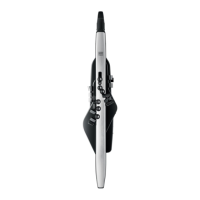42
Tone Parameters
Parameter Value Explanation
FILTER
Filter Type
TVF, VCF
Selects the type of lter.
MEMO
TVF stands for Time Variant Filter, a lter
that lets you specify in detail how the
frequency components of the sound
change over time.
If you select VCF, the polyphony will be
lower than if you select TVF.
TVF Type
Selects the type of TVF lter.
* If Filter Type is set to VCF, this will be LPF.
OFF No lter is used.
LPF
Low Pass Filter.
This cuts the frequencies in the region
above the cuto frequency (Cuto
Frequency).
Since this cuts the high-frequency
region, the sound becomes more mellow.
This is the most common lter used in
synthesizers.
BPF
Band Pass Filter. This leaves only the
frequencies in the region of the cuto
frequency (Cuto Frequency), and cuts
the rest. This can be useful when creating
distinctive sounds.
HPF
High Pass Filter.
This cuts the frequencies in the region
below the cuto frequency (Cuto
Frequency).
This is suitable for creating percussive
sounds emphasizing their higher tones.
PKG
Peaking Filter.
This emphasizes the frequencies in the
region of the cuto frequency (Cuto
Frequency).
You can use this to create wah-wah
eects by employing an LFO to change
the cuto frequency cyclically.
LPF2
Low Pass Filter 2.
Although frequency components above
the Cuto frequency (Cuto Frequency)
are cut, the sensitivity of this lter is half
that of the LPF.
This makes it a comparatively warmer low
pass lter. This lter is good for use with
simulated instrument sounds such as the
acoustic piano.
* If you set “LPF2,” the setting for the
Resonance parameter (p. 42) will be
ignored.
LPF3
Low Pass Filter 3.
Although frequency components
above the Cuto frequency (Cuto
Frequency) are cut, the sensitivity of this
lter changes according to the Cuto
frequency.
While this lter is also good for use with
simulated acoustic instrument sounds,
the nuance it exhibits diers from that
of the LPF2, even with the same TVF
Envelope settings.
* If you set “LPF3,” the setting for the
Resonance parameter (p. 42) will be
ignored.
VCF Type
VCF1,
J P,
MG,
P5
Each setting simulates the operation of
an analog synthesizer’s LPF. In particular,
MG, JP, and P5 are types that are suitable
for reproducing synthesizer sounds of
the past.
* This is valid when the Filter Type is “VCF.”
Parameter Value Explanation
Filter Slope
-12, -18, -24
(dB/Oct)
Selects the slope (steepness) of the lter.
For VCF, you can choose -12, -18, or -24.
For TVF, only -12 or -24 can be selected.
If Filter Type is TVF, the following
limitations apply.
5 You can specify only -12 dB or -24 dB. If
you specify -18 dB, the sound generator
operates internally with the -12 dB
setting.
5 If you specify -24 dB, the polyphony will
be lower than if you specify -12 dB.
Resonance 0–1023
Emphasizes the portion of the sound in
the region of the cuto frequency, adding
character to the sound. Excessively high
settings can produce oscillation, causing
the sound to distort.
Level
Frequency
Cuto Frequency
High
Low
Reso Velo Sens -100–+100
Use this parameter when changing the
resonance to be applied as a result of
changes in playing velocity.
Specify a positive “+” value if you want
resonance to increase when you play
strongly, or a negative “-” value if you
want it to decrease.
Vib Cuto Sens -100–+100
Species how the TVF Depth of LFO1
is aected by the program’s Modify Vib
Depth.
HPF Cuto 0–1023
Species the cuto frequency of the -6 dB
high-pass lter.
* This is valid when the Filter Type is “VCF.”
Cuto Freq 0–1023
Selects the frequency at which the
lter begins to have an eect on the
waveform’s frequency components.
With “LPF/LPF2/LPF3” selected for the
TVF Filter Type parameter, lower cuto
frequency settings reduce a tone’s upper
harmonics for a more rounded, warmer
sound. Higher settings make it sound
brighter.
If “BPF” is selected for the Filter Type,
harmonic components will change
depending on the TVF Cuto Frequency
setting. This can be useful when creating
distinctive sounds.
With “HPF” selected, higher Cuto
Frequency settings will reduce lower
harmonics to emphasize just the brighter
components of the sound.
With “PKG” selected, the harmonics to
be emphasized will vary depending on
Cuto Frequency setting.
TONE/PARTIAL/FILTER

